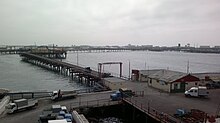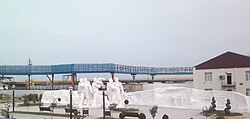|
Neft Daşları
Neft Daşları (pronounced [ˈneft dɑʃlɑˈɾɯ] lit. 'Oil Rocks') is an industrial settlement in Baku, Azerbaijan. The settlement forms part of the municipality of Çilov-Neft Daşları in the Pirallahy raion.[2] It lies 86 km (53 mi) away from the Azerbaijani capital Baku, and 39 km (24 mi) from the nearest mainland shore in the Caspian Sea. A full town on the sea, it was the first oil platform in Azerbaijan, and the first operating offshore oil platform in the world, incorporating numerous drilling platforms. It is featured in Guinness World Records as the world's first offshore oil platform.[3] The settlement began with a single path out over the water and grew into a system of paths and platforms built on the back of ships sunk to serve as the Neft Daşları's foundation.[4] The most distinctive feature of Neft Daşları is that it is actually a functional city with a population of about 2,000 and once comprised over 200 km (120 mi) of streets built on piles of landfill.[5]  EtymologyThe settlement was originally named as Chornye Kamni (Russian for "Black Rocks"), but was later renamed to Neftyanye Kamni (Russian "Petroleum Rocks"), in Azerbaijani nowadays Neft Daşları (id.), replacing the allusion to the black colour of oil with a reference to the substance itself.[6][7] HistoryConstruction of the settlement The first large-scale geological study of the area was conducted in 1945–1948.[8] The settlement of Neft Daşları was built after oil was discovered there on 7 November 1949[9] at 1,100 metres (3,600 ft) beneath the Caspian Sea. It became the world's first offshore oil platform.[10][11] By 1951, the Neft Daşları was ready for production, equipped with all of the infrastructure needed at the time. Drilling platforms were erected, oil tanks installed, and docks with enclosures for ships were built. The first oil from the Neft Daşları was loaded into a tanker in the same year.[12] In 1952, the systematic construction of trestle bridges connecting the artificial islands was begun. A number of Soviet factories constructed crane assemblies especially for use on the Neft Daşları, along with a crane barge that could carry up to 100 tons of oil. The assemblies were equipped with diesel hammers used to drive piles into the sea floor.[12] Large-scale construction started on the settlement in 1958, which included nine-story hostels, hotels, cultural palaces, bakery factories and lemonade workshops.[8] The mass development of Neft Daşları continued during 1976–1978 with the building of a five-story dormitory and two oil-gas compressor stations, the installation of a drinking water facility, and the construction of two underwater pipelines to the Dubendi terminal, each with a diameter of 350 millimetres (14 in).[8] In addition, a flyover for vehicular traffic was created.[8] As a result, the area of the settlement grew to around 7 hectares (17 acres) in the 1960s, with the length of the steel trestle bridges joining the man-made islands exceeding 200 kilometres (120 mi),[12] although much has since fallen into the Caspian sea. Post-independenceIn November 2009, the settlement celebrated its 60th anniversary.[13][14] Over the last 60 years, the oilfields of Neft Daşları have produced more than 170 million tons of oil and 15 billion cubic metres of associated natural gas.[12] According to present-day estimates by geologists, the volume of recoverable reserves is as high as 30 million tons.[12] The oil platforms have gradually fallen into disrepair, and no refurbishment plans are currently underway.[9] DemographyThe population varies from time to time in the settlement. As of 2008, the platforms have a combined population of about 2,000 men and women, who work in week-long offshore shifts. At one point[when?] 5,000 people worked there.[15] Oil extractionThe oil extraction is carried out from the shallow water portion of the Absheron geological trend.[citation needed] AccidentsOn 4 December 2015, three workers of SOCAR were reported missing after part of the living quarters fell into the sea due to a heavy storm.[16] In popular culture
References
External linksWikimedia Commons has media related to Neft Daşları.
Further reading
|
||||||||||||||||||||||



